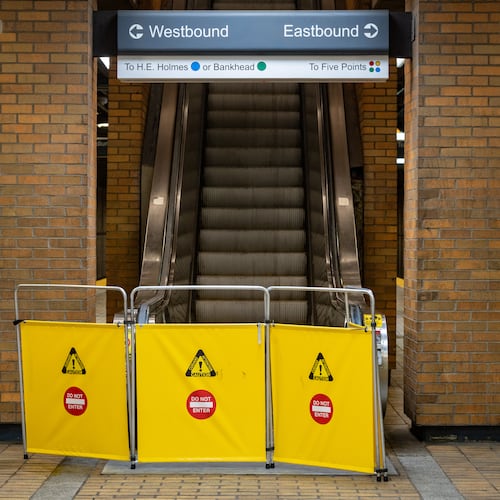Gordon Bolt loves walking his dog around the lake at Martin’s Landing, a 2,000-home subdivision in the wooded hills of Roswell, an area that sometimes resembles a nature preserve. Egrets, herons, diving ducks and Canada geese live near the lake, which was created by an earthen dam built in the late 1960s.
Covered in grass, the dam is 30 feet high and 800 feet long, with benches and a walking path along the top and concrete spillways on either side. The water runs to the Chattahoochee River, about a quarter mile away. It’s an idyllic setting.
Bolt, however, is weary of Martin’s Landing’s long-running conflict with the state over dam repairs. He wonders if fixes are really necessary.
“I think it just survived the worst flood in 100 years and it looks the same as it did before,” Bolt said, unconvinced. “If the worst happens and it bursts, what will happen? It will run into the Hooch.”
For 12 years, Georgia Safe Dams, a state agency, has told Martin’s Landing to make major dam repairs and absorb the cost. The Martin’s Landing Foundation won’t reveal the possible financial burden, but residents say it’s $3 million. And it’s unclear if that includes a proposed beautification program for the lake.
The dam was a political issue during the recent mayoral election. Roswell asked legislators for financial help, for low-cost loans. State Rep. Mark Burkhalter asked for a reassessment of the situation in a letter to Georgia Safe Dams, but the agency didn’t change its stance.
Once the 40-year-old dam survived last September’s floods, city leaders wanted the state order dismissed. It hasn’t happened yet.
“Mother Nature has tested the dam and said it works fine,” Mayor Jere Wood said. “To say let’s tear down this dam is to say let’s waste a lot of money. This is not the time for this country to be wasting money on bureaucratic rules.”
Asked about Martin’s Landing’s argument, state officials said they’ve heard it before.
“They’re comparing apples to oranges in terms of criteria,” said Ed Fiegle, Georgia Safe Dams program manager. “It was a significant storm. But it wasn’t what the dam was supposed to safely pass.”
The Martin’s Landing Foundation has been relatively quiet on the subject as of late. On Wednesday, the community group issued a statement that said it has complied with a 2007 administrative order from Georgia Safe Dams. Wood has offered his support for the group.
Martin’s Landing, a half mile from Ga. 400, is a collection of single-family homes, condos and apartments developed in the 1970s. Recreation is important, and the community’s centerpiece is a 46-acre lake surrounded by a collective asphalt, concrete and dirt walking path.
Paula Winiski, former Roswell council member and a resident since 1980, said Martin’s Landing was built during “the beginning of the village concept.”
“You have all kinds of housing from apartments to large homes,” she said. “You have a big emphasis on environmentalism with big green belts. Almost everybody who lives here is pro-environment.”
Dam regulation, however, has been slow to take hold. Georgia Safe Dams has asked Martin’s Landing to make repairs since 1998. The state’s most pressing needs are fixing the older spillway and addressing “a slough,” or visible weakening, in the base of the sloping dry side of the grassy dam.
Tom Woosley, another Georgia Safe Dams program manager, said the agency issued an administrative order because the community didn’t move fast enough to fix the dam. However, Woosley admitted the state contributed to the slow process because budget cuts reduced his office staff and increased the workload on remaining employees.
Woosley said the state annually inspects 470 similarly sized dams because any structural failure could place lives in jeopardy. At Martin’s Landing, tennis courts and a swimming pool, but not residences, are all that separate the dam and the river.
The Martin’s Landing dam was different from other cases because it’s owned by a large group, Woosley said. Most dams are owned by small groups or individuals.
In May, an engineering firm hired by Martin’s Landing sent plans to Georgia Safe Dams for review. The solution was to close one of two spillways and build a new, 45-by-200-foot concrete spillway in a notch cut into the middle of the dam.
Woosley hasn’t reviewed the plans yet. Martin Shelton, a lawyer representing Martin’s Landing, won’t comment on the cost or the foundation’s plans until the state finishes its review.
People are impatient for a resolution. Fran Gimby, a 34-year Martin’s Landing resident, insists the dam is solid, but acknowledges the older spillway needs repair. She’s tired of waiting for something to happen, good or bad.
“We’re sitting on something that’s not going ahead like it should,” she said. “Don’t let us hang for years and years. Let’s get it done.”
About the Author
The Latest
Featured

